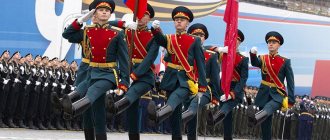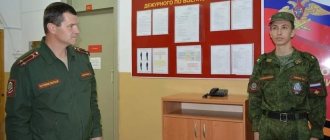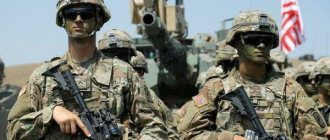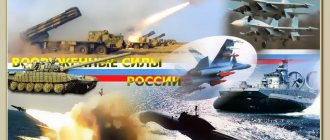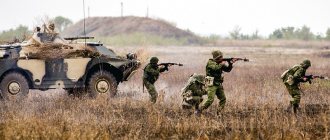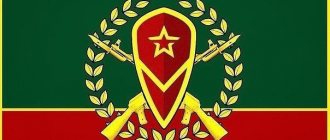Motorized rifle platoon - organization
A motorized rifle platoon includes a control group and three squads. Typically, the MSV operates as part of a company. However, in marching, combat security and reconnaissance, the MSV can act independently.
To solve individual problems, the platoon may be assigned additional forces from other branches of the military and special units.
Motorized rifle platoon control group
There are motorized rifle platoons operating on armored personnel carriers and infantry fighting vehicles.
Read on topic: Accommodation of personnel in a combat vehicle BMP and armored personnel carrier
The battalion commander is responsible for everything
The concept of promising units, units and formations at the battalion-brigade level
In recent years, we have seen a series of reforms in the structure of the Ground Forces at the brigade level (formerly the regiment-division level). At the same time, almost nowhere are there any detailed justifications for the reforms being carried out. It also looks strange that the changes in the upper levels of the army structure practically did not affect the battalion level. The article discusses ways to increase the capabilities of motorized rifle units, units and formations of the Ground Forces at the battalion-brigade level. The concept of their alternative structure and equipment is substantiated.
DIFFERENT MILITARY UNIT
Based on the experience of local wars, control should be decentralized in favor of tactical units of the size of a reinforced company - a reinforced battalion, consisting not only of infantry and armored units, but also of artillery and engineering units, as well as logistics support units. In a war with a superior enemy, excessive reliance on the deep rear would cause overload and vulnerability of communications and a practical blockade of the front, mainly the first echelon. Therefore, it is necessary to strengthen the support units in the battalion.
The primary factor for success in war is secrecy of maneuver. However, due to the appearance of modern reconnaissance equipment on the battlefield, the company becomes the largest covertly maneuvering unit.
Thus, on the modern battlefield, highly autonomous company tactical groups are required, formed on the basis of motorized rifle companies. Following this trend, the battalion will gradually turn into a heterogeneous military unit, giving way to the company as the main tactical unit. The participation of the battalion commander in combat control will decrease, so it is advisable to increase the number of motorized rifle companies in the battalion to four.
To preserve the maneuverability of company tactical groups and the battalion as a whole, all models of the battalion’s armored vehicles must be developed on a single base.
ENGINEERING AND SUPPORT SUPPORT
Modern warfare is characterized by an increase in the volume of engineering and sapper tasks at the level of tactical units. Based on the experience of local wars, units in the first echelon were often let down by the lack of a sufficient amount of engineering equipment, especially bulldozers and earth-moving machines, because positions were often held for several days, during which it was impossible to pull up equipment from the rear, but it was during this period that the troops suffered the greatest losses. With the massive proliferation of cluster munitions, this problem is becoming even more acute. The same thing happened with overcoming natural and artificial barriers, since there were not enough tank bridge layers in the first echelon. Providing engineering resources to units for each task requires a lot of time, so it is advisable to include an engineer unit in the battalion. At the same time, taking into account the complexity and variety of engineer-sapper equipment, their effective use and the organization of training of sappers require the creation of a fairly large unit consisting of several platoons: an engineer-sapper platoon, a mining platoon, a platoon for transporting engineering equipment and ammunition, an engineering and technical platoon, road engineering platoon.
It is advisable to include a demining department, a guided mines department, and a general-purpose engineering and sapper department in an engineer platoon. A platoon is needed to create controlled mine-explosive barriers (together with a mining platoon), conduct engineering reconnaissance and make passages through enemy barriers. It must be equipped with mine clearance equipment (including remote mine clearance machines), mine-explosive and other means. The platoon must also train military personnel of conventional motorized rifle units in the basics of mine explosives in relation to the installation and neutralization of all types of mine explosives.
The mining platoon must be equipped with minelayers and remote mining equipment based on the main equipment of the battalion. A platoon is necessary to create mine-explosive barriers, which (according to the experience of local wars) are one of the main means of defeating the enemy for the defending side.
The transportation platoon must be equipped with trawls and other attachments for tanks and infantry fighting vehicles, trucks and vehicles with lifting equipment. These vehicles could also be used for other transport and loading and unloading tasks, primarily for the transport of ammunition.
It is advisable to include a field water supply department, a field power supply department, and an earth-moving machines department (two earth-moving machines) in the engineering and technical platoon. Providing personnel with water often becomes a significant problem in war. It is characteristic that in Chechnya it was the convoys transporting water that were often ambushed, since they were forced to make regular trips to the place of water extraction and purification. The presence of an engineering and technical platoon will significantly increase the autonomy and capabilities of the battalion to create defensive and other structures.
It is advisable to include in a road engineering platoon a tank bridge laying squad with two tank bridge laying vehicles, or a light prefabricated bridge squad (for light wheeled battalions), and a barrier squad (equipped with a track-layer and an engineering barrier vehicle). With such equipment, the battalion will, in many cases, be able to operate in difficult terrain and under obstacles without additional engineering reinforcement.
Considering the close relationship between engineering tasks and logistics tasks, it is advisable for engineering units to be subordinate to the battalion logistics chief. The support platoon, repair and evacuation and medical platoons will also be subordinate to him. In this case, it is logical to create a single company of engineering and logistics support. At the same time, given the connection between the tasks of the reconnaissance and engineer platoon, as well as the mining platoon, it is advisable to transfer them to the reconnaissance unit of the battalion.
The medical platoon should be optimized more for the evacuation of the wounded and sick to the rear, rather than for their treatment. The main indicator of its work should be the time from the receipt of information about the injury of a serviceman to the time of transfer of this serviceman to a field hospital.
As the number of personnel and the number of various equipment and weapons in the battalion increases, the capabilities of the support platoon should be expanded. In particular, the platoon must have a double set of battalion food points, which will make it possible to organize food supply when the battalion moves in two marching columns or two military echelons. The ability to supply fuels and lubricants should be significantly increased. It is advisable to transfer the function of supplying ammunition to a platoon for transporting engineering equipment and ammunition.
INTELLIGENCE SERVICE
The increasing transience and decreasing scale of localization of battles characteristic of modern wars require independent decisions to be made at lower and lower levels of management. It is clear that the degree of independence of decisions must correspond to the level of awareness. This makes us think about creating a reconnaissance company in the battalion. Its composition may be as follows: a sniper reconnaissance platoon, a platoon of reconnaissance vehicles, a platoon of unmanned aerial vehicles, a special purpose platoon, an engineer platoon, a mining platoon.
The commander of a sniper reconnaissance platoon can be the head of all snipers in the battalion, which will allow for the organization of full-fledged training for snipers in rifle squads. In the context of increasingly complex designs of weapons and accessories for them, a battalion needs a small arms control and maintenance department, which would be advisable to introduce into the structure of a sniper platoon. The platoon could be the “base” for training and testing the knowledge of all battalion soldiers in small arms, while selecting good snipers, as well as monitoring the technical condition of small arms.
A platoon of reconnaissance vehicles can include several (3–6) armored vehicles based on the main equipment of the battalion, equipped with complexes of technical reconnaissance equipment: optical, thermal (infrared), seismic-acoustic, radar, coordinate radio engineering. The main task of the platoon will be to issue the exact coordinates of targets to organize fire destruction of the enemy. Thus, these vehicles will serve as mobile forward observation posts.
A UAV platoon must have at least four UAVs with a flight time of at least two hours and a guaranteed range of at least 15 km, with the ability to control them from a control point on the march.
A special-purpose platoon is needed to conduct reconnaissance, assault and special operations, organize ambushes, raids and sorties. The role of these tasks has increased many times over the experience of local wars, and a unit specialized in them in the battalion is necessary.
ARTILLERY SUPPORT
In modern warfare, the role of artillery fire support has increased significantly. At the same time, the provision of motorized rifle battalions with support from artillery battalions during the transition to a brigade structure decreased (due to the “loss” of division-level artillery), which means it is necessary to strengthen the artillery component of the motorized rifle battalion itself. It is advisable for a battalion to have the same type of self-propelled guns of 120 mm caliber instead of transportable and portable mortars. Due to the wide range of simultaneously performed tasks of various sizes, the battalion’s artillery battery should include two platoons of four self-propelled guns. Such an organization will allow (if necessary) to fire in half-platoons (two self-propelled guns). The lack of light mortars is compensated by high mobility and readiness to open fire, and caliber unification will improve fire control and ammunition supply.
Considering the extremely high assessment of the effectiveness of the use of heavy flamethrower systems (TOS), it is advisable to include four vehicles in an artillery battery, combined into a platoon. It is inappropriate to classify TOS as brigade artillery due to insufficient fire range.
Obviously, the battalion commander must have his own mobile anti-tank reserve. Such a reserve could be a platoon of self-propelled anti-tank systems (four vehicles). For better coordination with artillery, it is advisable to include an ATGM platoon in an artillery battery. The fire control system must ensure the launch of ATGMs against targets outside the visual zone by targeting the missile via a television channel. Preliminary target data can be obtained from a forward observer, a UAV, or other reconnaissance assets. Thus, this ATGM should perform the functions of a battalion-level guided missile weapon complex.
For effective fire control, the capabilities of ground spotters and even UAVs may not be enough, the use of which may be excluded in case of strong enemy air defense. Therefore, it is necessary to equip the battery with radar (as the main) and sound (as backup) means of artillery reconnaissance and fire control. These means should provide reconnaissance and control of firing results at a range of up to 15–20 km. Thus, an artillery reconnaissance platoon is required, including (at least) a radar reconnaissance section and a sound reconnaissance section.
A major war of the future will be characterized by the enemy's widespread use of precision-guided aviation weapons, UAVs and helicopters. The battalion, taking into account the increased autonomy within the brigade and the wide scope of the area of operation, must have its own strong air defense systems, including both self-propelled air defense systems and MANPADS. I propose to include in the air defense company two platoons of air defense missile systems (four vehicles each) and two platoons of MANPADS (two infantry fighting vehicles and 6-8 crews of MANPADS each). If necessary, each motorized rifle company can be given half a platoon of MANPADS (three or four crews on infantry fighting vehicles) and half a platoon of self-propelled air defense systems (two air defense systems).
COMMUNICATION AND CONTROL
In wartime, the battalion will need to deploy several communications and control subsystems (commander, artillery chief, logistics chief, air defense chief, reconnaissance chief). It is advisable to entrust the deployment and maintenance of these subsystems not to disparate units within the corresponding companies, but to a single structure - a communications and control company. In addition to the control and communications platoon, the communications and control company should include a security platoon so as not to distract motorized rifle and other units from their main tasks.
One of the main tasks of the control platoon will be to ensure the operation of the automated troop control system (ATCS) and the associated navigation and geodetic support system. It is advisable to include in the platoon a department for servicing automated control systems, a department for topographic and geodetic and navigation support, as well as a department for control vehicles. The first two squads, of course, should be staffed not by ordinary soldiers, but by technical specialists with appropriate education (preferably higher education).
The communications platoon must be equipped with modern digital automatic telephone exchanges for a secure telephone network for several dozen subscribers, a set of portable backpack radios, sets of equipment for connecting to core networks via wire, satellite, radio relay and other communication channels, diagnostic and repair tools and other equipment.
In addition to the radio network at the battalion level, it may be necessary to deploy a secure communications network with the possibility of integration into higher-level communication networks. To organize it, you need two compact digital mini-PBXs (main and backup) with a capacity of up to 64 subscribers.
A specialized security platoon is intended primarily to guard the battalion command post. A security platoon is not intended for maneuverable actions and may be more “heavy” than a motorized rifle platoon. It is advisable to include large-caliber heavy machine guns in its armament, as well as technical security equipment. A security platoon may include the following sections: two or three patrol and guard units, a technical unit, and a machine gun unit.
So, the promising battalion will include:
– four motorized rifle companies (three armored and three motorized rifle platoons);
– reconnaissance company (sniper reconnaissance platoon, reconnaissance vehicle platoon, unmanned aerial vehicle platoon, special purpose platoon, engineer platoon, mining platoon);
– artillery battery (two platoons of self-propelled guns, a platoon of TOS, a platoon of self-propelled anti-tank systems, a platoon of artillery reconnaissance);
– air defense company (two platoons of air defense missile systems, two platoons of MANPADS);
– engineering and logistics support company (engineering and technical platoon, engineering and road platoon, platoon for transportation of engineering equipment and ammunition, support platoon, repair and evacuation platoon, medical platoon);
– control and communications company (control platoon, communications platoon, security platoon).
The number of such a battalion will be about 800 people. The “heavy” battalion will be armed with at least 28 infantry fighting vehicles, 24 tanks, 4 self-propelled ATGMs, 8 self-propelled guns of 120 mm caliber and 4 TOS. To organize air defense, the battalion will have 8 air defense missile systems and 8 man-portable air defense systems, as well as more than 50 automatic guns on infantry fighting vehicles and more than 50 multi-purpose anti-tank systems on tanks and infantry fighting vehicles.
The battalion will be able to conduct reconnaissance using its own means in the optical, infrared, radar, and sound ranges at a distance of at least 15 km, and the automated control system will provide automated target designation and preparation for firing. Thanks to its own means of engineering and logistics support, such a battalion will be able to operate for a long time without reinforcement means, in isolation from the main forces.
Prospective brigade structure
HOW MANY BATTALIONS SHOULD BE IN A BRIGADE?
The transition to a brigade structure made it possible to get rid of an excessive number of management links, which, of course, is a progressive step. However, it is not clear why the number of motorized rifle and tank battalions in such a formation (unit) did not increase compared to the previous structure of the regiment. In a major war, the brigade's insufficient capabilities will require the creation of an intermediate level of command between them and the operational commands, that is, the re-creation of divisions under a new guise.
To eliminate this shortcoming, the number of motorized rifle battalions in a brigade should be increased to a number intermediate between a regiment and a division. With the current battalions, this, of course, would complicate management too much, but in a structure with promising battalions of increased independence, this problem can be solved.
To increase the maneuverability of the brigade, all armored and unarmored vehicles in it must be unified by track. Self-propelled artillery installations, vehicles of logistics support units and other equipment in heavy and light tracked brigades should be on a tracked base, and in light wheeled brigades - on a wheeled base (for example, on trucks, armored vehicles and armored personnel carriers). In my opinion, it would be optimal to include in a “heavy” brigade five “heavy” motorized rifle battalions (as a universal means) and one tank battalion (no longer necessary, since motorized rifle battalions will already be half tank). The “light brigade” consists of six light battalions of one type of equipment. We would have three types of brigades for operations primarily in the corresponding types of terrain: “heavy” for open areas, “light wheeled” for populated areas and “light tracked” for difficult terrain.
In modern warfare, effective remote fire destruction of the enemy is an almost necessary basis for active operations of combined arms groups. In a major war, the Ground Forces cannot fully count on the support of their aviation, since it will either be destroyed or will carry out air defense missions and strike targets in the enemy’s operational depths. The entire burden of responsibility for the fire defeat of the enemy in the interests of the Ground Forces will fall on the artillery. Therefore, it is necessary, without drawing false conclusions from the experience of wars in conditions of air supremacy, to significantly strengthen the artillery component in the brigade.
It is advisable to increase the number of divisions of self-propelled howitzers to three, rocket artillery divisions to two, and to include in the structure a division of brigade-level missile systems (Hermes class of guided missile systems). Only with this number of fire units will the fire destruction planning group in the brigade turn from a bureaucratic superstructure above the divisions into a small fire destruction planning headquarters under the control of the brigade artillery chief. Such a headquarters should also be fully responsible for organizing interaction with aviation; it should be given maximum independence in decision-making in order to relieve the main brigade headquarters of unusual tasks as much as possible.
An artillery division must regularly include a motorized rifle company (for ground defense of positions) and an air defense company. The artillery division also needs a company of sappers (with equipment for building shelters and constructing roads). When in the forest, one of the most necessary things in artillery is a chainsaw. In modern conditions, requiring decentralized actions, it is advisable to structure the main fire weapons of divisions into two batteries of two platoons of four installations each. Moreover, there should also be regular half-platoons of two installations, which will allow the most flexible organization of fire support for motorized rifle units.
In addition, the brigade must have the following battalions (divisions): reconnaissance and electronic warfare, air defense of stationary objects, air defense of mobile objects, engineering and headquarters. By headquarters battalion I mean a communications and control unit with its own engineering and other means, capable of independently ensuring the deployment, operation, security and defense (and partly air defense) of the main and reserve command posts and brigade-level communications centers. Such a brigade would be closer in structure to the war-tested structures of the groupings of our troops operating in Chechnya, but taking into account the possibility of war with an equal or superior enemy.
The brigade also needs a unit of multi-purpose helicopters. In modern warfare, helicopters are needed by reconnaissance units, electronic warfare, engineer troops, and can be used to land motorized rifle units in tactical landings and solve many other tasks. The lack of multi-role helicopters at the brigade level will make coordination with them extremely difficult, but the maintenance and repair of brigade helicopters must be organized at the level of technical services of the operational and operational-strategic commands.
Based on the experience of local wars, engineering support for troops should be strengthened at all structural levels. The engineer-sapper battalion, on the basis of which barrier installation groups will be formed, often conducting almost independent combat operations, must consist not only of sappers, but also of infantry with anti-tank and anti-aircraft weapons, and have all-terrain equipment. Both for the use of various incendiary and smoke agents, and for the fight against them, it is advisable to include the RCBZ company in the sapper battalion and company.
Electronic warfare tasks are often inseparable from reconnaissance tasks and therefore must be concentrated in a single structure, a technical reconnaissance and electronic warfare battalion. It is advisable to include two or three UAV companies in a battalion, a radar and sound-metric artillery reconnaissance company, a radio-technical reconnaissance and electronic warfare company, a reconnaissance vehicle company, a combat and logistics support company (air defense, engineering logistics, ground defense). The need for several UAV companies is due to the need for a large number of UAVs of at least two types.
Based on the experience of local wars, the main burden of the fight against saboteurs lies with brigade-level commands. Brigades also need their own reconnaissance and sabotage detachments, therefore it is at the brigade level that there must be a special battalion that combines the functions of reconnaissance and sabotage units with the functions of combating enemy sabotage and reconnaissance groups. The battalion also requires a counterintelligence and anti-terrorism department with several operational employees.
To coordinate the actions of a technical reconnaissance battalion and a special battalion, an intelligence chief with the status of deputy brigade commander is required, who must have his own small headquarters for planning reconnaissance operations and processing intelligence data.
DO NOT CONFUSE COMMANDER WITH MANAGER
Of course, with such a structure, the brigade should not be a military unit (administrative and economic unit). The brigade headquarters should be focused on leading the battle, and not on solving administrative and economic problems. Thus, a brigade should be a formation, and a battalion should be a military unit.
It is not practical to include even rear units in a brigade-level structure. In addition, the presence of brigade logistics services will lead to the placement of large stationary warehouses in a zone closer than 30 km from the front, which, if the enemy uses modern artillery (not to mention missile systems), means their deliberate destruction. Supply tasks must be resolved directly between battalions and rear services of operational-strategic (and in wartime operational) commands. There will be nothing supernatural in such a rear organization if you automate and optimize rear management at the upper levels, namely:
– create and implement a unified classifier of supplies in the work of rear services;
– automate the management of military logistics by introducing barcoding and automated tracking of the movement of supplies and their shipments, which has already become an absolute rule in civilian logistics;
– eliminate reverse cargo flows, in particular, make it a rule to transfer replaceable emergency stocks to the current supply of the same unit instead of meaningless delivery to a higher warehouse;
– introduce a unified system for automated control of traffic flows of rear services, integrated with GLONASS;
– already in peacetime, prepare for deployment an extensive network of warehouses, repair bases, hospitals and other rear elements of operational commands; to work out their interaction directly with the rear services of battalions (divisions).
There cannot be full-fledged technical services at the brigade level. Issues of maintenance and repair should be resolved by the deputies for armament of the battalion (division) commanders directly with the technical services of the operational (operational-strategic) commands. Thus, the unnecessary transfer level of deputy brigade commanders for weapons will be eliminated.
The brigade commander must be responsible primarily for combat operations, and not for the daily activities of the troops. Therefore, he needs not purely functional deputies (for educational work, for weapons), but linear-functional ones: chief of staff, chief of motorized rifle units, chief of artillery, chief of air defense, chief of intelligence, chief of engineer units, chief of brigade aviation. The presence of a powerful brigade headquarters will allow each of these commanders to be allocated a specialized planning group (small headquarters). The small headquarters will have to take upon itself the planning of the actions of the battalions (divisions) subordinate to the corresponding commander. Thus, the brigade structure will have four non-standard groups (motorized rifle, artillery, reconnaissance, air defense), which will actually reduce the number of command and control facilities at the main brigade headquarters to seven.
Motorized rifle platoons on armored personnel carriers
The MSV on an armored personnel carrier consists of a control group and three motorized rifle squads. The platoon control group includes:
- Platoon commander armed with AK-74 and Makarov Pistol (PM);
- Deputy platoon commander (armed with AK-74);
- Platoon sniper (SVD weapons);
- Machine gunner with a Kalashnikov machine gun (PK) or its modifications (PKM);
- Assistant machine gunner with AK-74;
- The shooter is a nurse AK-74.
The organization and armament of a motorized rifle squad can be read in the relevant articles on the site:
- Organization of MCO;
- Small arms MSO.
Position history
In 1918, the structure of units and divisions of the Red Army was adopted. The then Charter provided for standard positions for employees, among whom was a platoon commander.
During the Civil War, general titles became widespread in the Red Army:
- privates - soldiers, Red Army soldiers;
- command staff - commanders, paint commissioners.
Reference. The introduction of the rank of “officer” was out of the question at that time, because it was directly connected with the White Guards - opponents of the Red Army.
In 1924, a revised list of ranks by position was adopted. Then the list was divided into 4 groups: junior, middle, senior and senior command staff. The rank of platoon commander belonged to the middle command staff.
The established standard positions and the procedure for addressing soldiers did not change until the Red Army and the Navy introduced personal ranks. This happened in 1935.
Relations between military personnel of the Russian army must be strictly regulated. The normative document controlling the military activities of the armed forces is the Charter. It contains a set of laws that define the responsibilities of each person serving in the Armed Forces, as well as some requirements and techniques associated with the service.
Platoon on an infantry fighting vehicle
Read on topic: Unit defense at night
A motorized rifle platoon on an infantry fighting vehicle also consists of a control group and three motorized rifle squads. The composition of the control group is similar to the control group of the MSV on an armored personnel carrier. Only the composition of the departments on infantry fighting vehicles differs, about which read the relevant articles (link to articles above)
Total. A motorized rifle platoon consists of 32 soldiers on an armored personnel carrier, and 30 soldiers on an infantry fighting vehicle.
The MSV's armament includes:
- Kalashnikov assault rifles: 18 units for armored personnel carriers and 16 units for infantry fighting vehicles;
- AKSU-74: 6 units;
- PC (Kalashnikov machine gun): 1 unit;
- (Dragunov sniper rifle): 1 unit;
- RPKT (machine gun on vehicles): 3 units;
- RPG-7v (hand grenade launchers): 3 units each.
Read on topic: Motorized rifle battalion of the Russian Army

